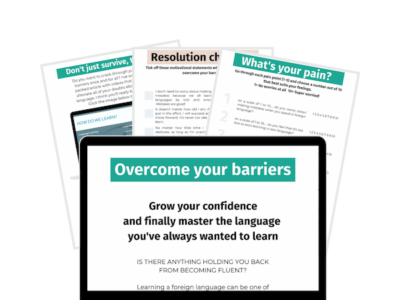Why are prepositions important in Italian?
Learning how to use Italian prepositions correctly will make all the difference in the world when it comes to speaking like a native speaker.
Prepositions are often tricky to learn, but they are some of the most commonly used Italian words.
What is tricky are not the words themselves, of course, but how to use them and where to place them within the sentence, and they are incredibly important to make sure you get the right meaning across.
In this post, you will find all you need to know about Italian prepositions and how to use them in all kinds of contexts.
Whenever you’re in doubt, just come back here and have a quick read… You’ll learn how to use the correct preposition in no time!
What are prepositions?
Let’s start from the basics: a preposition is a short word, usually made up of just two or three letters in the Italian language, that explains how the rest of the words in a sentence are connected or related. It basically provides us with context to know how different concepts are linked.
Prepositions can complement an adjective, adverb, verb, noun, or pronoun.
What is tricky about Italian prepositions is that they are usually similar to English prepositions, which is surely helpful to know, but they cannot always be used in the exact same way.
Which are the Italian prepositions?
The key prepositions are the simple prepositions (preposizioni semplici) are di, a, da, in, con, su, per, tra/fra.
And here are the general English translations for them, just so you have an idea.
- Ds – of / from / about
- A – at / to
- Da – from / since / by
- In – in
- Con – with
- Su – on / about / above
- Per – for
- Tra/Fra – in / between / among
Let us now look at each preposition in more detail, with examples of their usage in different Italian sentences.
How to use di and da?
As we’ve seen, di can be translated into the English of, from, and about. The preposition di is used:
- To talk about ownership
Questa borsa è di Eleonora.
This bag is Eleonora’s.
- To describe materials and substances
La mia maglia è di cotone.
My shirt is made of cotton.
- With city origins (after the verb essere)
Io sono di Roma, e tu di dove sei?
I am from Rome; where are you from?
- With some expressions of time: parts of the day and days of the week
Mi piace leggere di sera.
I like reading at night.
Di lunedì vado a lezione di yoga.
On Mondays, I go to a yoga class.
- To describe topics with verbs such as parlare (to speak/talk), discutere (to discuss), etc.
Stiamo parlando di politica.
We’re talking about politics.
Questo caffè è molto più buono di quello.
This coffee is much better than that one.
- For authorship
Ho comprato un libro di Alessandro Baricco.
I bought a book by Alessandro Baricco.
- To explain quantities
Vivo in un edificio di 20 piani.
I live in a 20-floor block.
Da can be translated as from, since, or by and it is used:
- With origins of movement and motions away from
L’ho buttato giù dalla finestra.
I threw it out the window.
Sono partita da casa mia.
I left my place.
- With movements toward a person
Oggi vado a pranzo da Michele.
Today I’m going for lunch at Michele’s.
- To talk about what needs to be done (followed by an infinitive)
Ho tantissimo lavoro da finire!
I have too much work to finish!
- To describe how long something has been going on
Studio italiano da 2 anni.
I’ve been studying Italian for 2 years.
- To describe the agent in passive sentences
Questa commedia è stata scritta da Gogol.
This comedy was written by Gogol.
How to use in and a?
In is usually translated as in so it’s pretty simple! We use it:
- To describe the movement to or state in a place (with countries and regions, with cities, we use a)
Sono in Francia.
I am in France.
Domani andiamo in Puglia.
Tomorrow we are going to Puglia.
- For traveling by means of transportation
Siete venuti in treno o in aereo?
Did you come by train or by plane?
- When talking about seasons
I fiori sbocciano in primavera.
Flowers bloom in spring.
- To describe the amount of time it takes to do something
Ho finito il libro in soli tre giorni.
I finished the book in just three days.
A is the Italian equivalent of at and to. It is used:
- To talk about the movement to a city, location or being in a city or location
Domani vado a Milano per lavoro.
Tomorrow I am going to Milan for business.
Andiamo al mare questo weekend?
Shall we go to the seaside this weekend?
- To say when or at what time something is happening
Esco dalla palestra alle sei di sera.
I leave the gym at 6 pm.
- To say you’re giving something to someone
Ricordami che devo dare 10 euro a Maria.
Remind me I need to give 10 euros to Maria.
How to use su and con?
Su can be translated as on, above, or about and we use it to indicate:
- That something is on top of or above something else
Il tuo quaderno è sul tavolo.
Your book is on the table.
- The subject of a topic
Ieri ho guardato un documentario sulla storia russa.
Yesterday I watched a documentary about Russian history.
Con is the equivalent of with. You can use it:
- To talk about company
Andiamo al cinema con mia cugina stasera.
Tonight we’re going to the cinema with my cousin.
- To describe the use of a tool
Ho fatto un succo di mora con il frullatore.
I made blackberry juice with the blender.
How to use per, tra and fra?
Per is the Italian equivalent of for. It is used:
- To talk about reason or cause
Mi sono trasferita qui per lavoro.
I moved here for work.
- To express duration
Abbiamo parlato per più di 2 ore.
We talked for over 2 hours.
- To talk about a country of destination or a transport passing through one
Il mio volo passa per la Danimarca.
My flight goes through Denmark.
Domani Gianluca parte per la Colombia.
Gianluca is leaving to Colombia tomorrow.
Tra and fra are interchangeable prepositions: they have exactly the same meaning, and using one, or the other is up to the speaker’s personal preference and stylistic decisions.
Use these to:
- To describe something that is located between two things
Mi è caduto il telefono tra il divano e la credenza.
My phone fell between the sofa and the dresser.
- To indicate in how long something will happen
Il concerto è tra una settimana.
The concert is in one week’s time.
- To differentiate between options
Tra i due preferisco questo.
I prefer this between the two.
Practice with Quizlet
Here's a set of flashcards and quizzes to practice this grammar topic.How to use Italian prepositions with articles?
Now that you’ve learned how to use the Italian prepositions in a sentence, there is one more thing to know about them: di, a, da, in and su can become articulated prepositions (preposizioni articolate) when they are used before a definite article, as you probably have noticed in the examples above.
To form these we simply join the preposition with the definite article we need, so that they become one word (for example, di+il= del; a+le= alle etc.)
Have a look at the Italian preposition chart below, in which you’ll find all the major prepositions in combination with articles.
| il | lo | la | l’ | i | gli | le | |
| di | del | dello | della | dell’ | dei | degli | delle |
| a | al | allo | alla | all’ | ai | agli | alle |
| da | dal | dallo | dalla | dall’ | dai | dagli | dalle |
| in | nel | nello | nella | nell’ | nei | negli | nelle |
| su | sul | sullo | sulla | sull’ | sui | sugli | sulle |



















